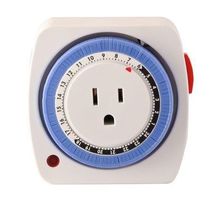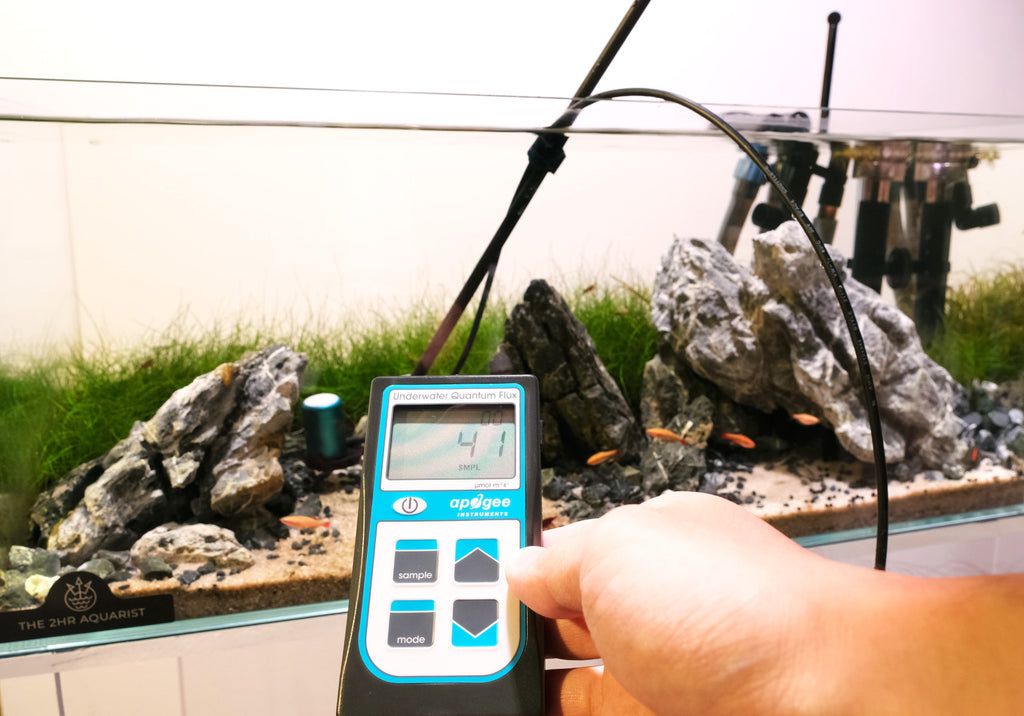Introduction
While algae removal techniques can be effective, they should not be the default method to keep a tank algae free. The cleanest tanks are the ones that are algae resistant through good design. This article will go over key considerations in setting up an algae resistant tank. This will include equipment considerations from when the tank is set up, and how much hardscape is used, what is the percentage of the available substrate is planted. The strategies for keeping a fully planted “Dutch style” tank from getting algae is quite different from keeping a sparsely planted Iwagumi setup from getting algae.
We will look at the main factors that determine algae presence in a tank and look at some tank examples on top of that.
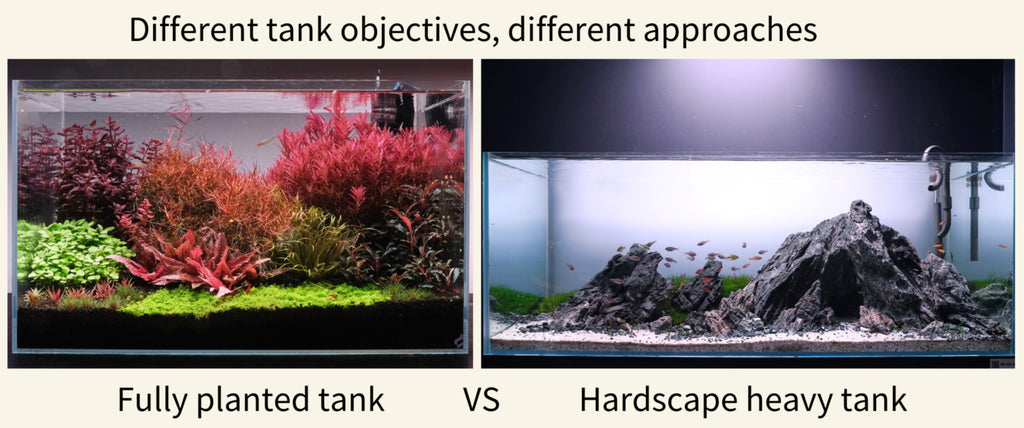
Two very different styles of tank, yet each can keep algae at bay if designed properly. Let us start with the first factor – how healthy plants are naturally algae resistant.
1.Healthy plants are algae resistant, unhealthy plants attract algae
Healthy plants that receive sufficient nutrients, light and carbon in a conducive environment produce anti-microbial chemicals that prevent pathogens and algae from attacking the plant. Unhealthy plants that do not receive what they require will channel energy to defending the newest leaves, but face quick deterioration of older growth. You will often see that when algae attacks a plant, it affects the older leaves first, while the newer leaves remain bright and clean.
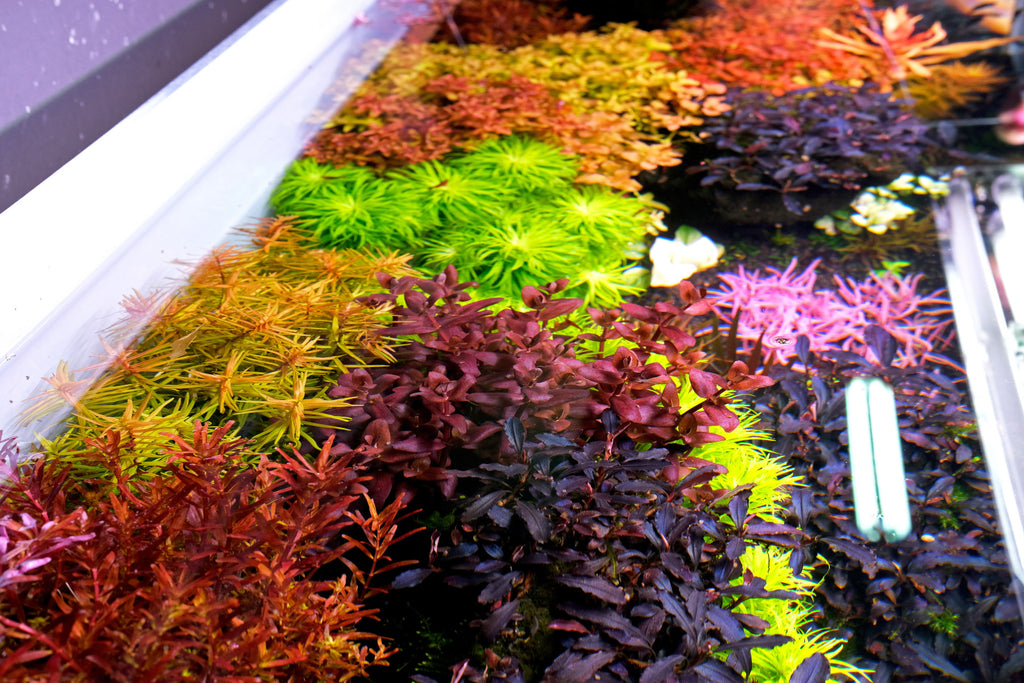
Stem plant tops growing close to the top of the tank receive a huge amount of light. Light levels at this level measure above 400umols of PAR. However, notice how these plants remain algae free despite the very high light levels. If light alone was the cause for algae, then the top portions of the plants will be the most affected, but this is not the case. Healthy plants are naturally algae resistant.
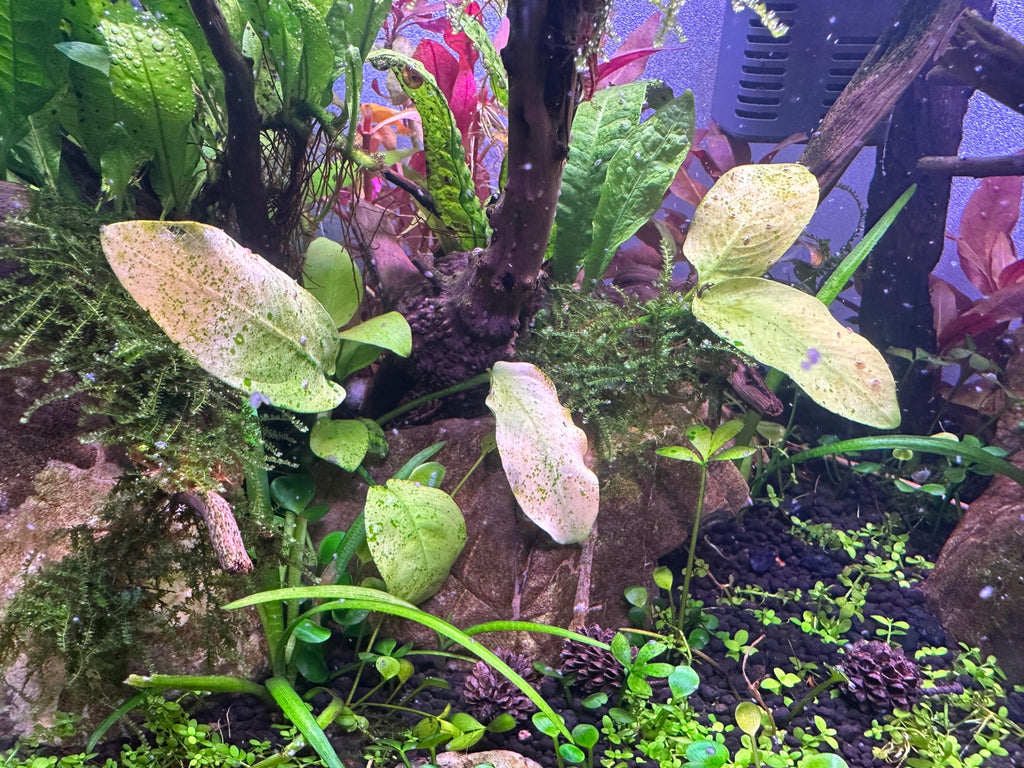
Unhealthy plants that are nutrient deficient tend to have pale growth that will often attract algae. This tank probably receives much less light than the tank above, but poor plant health brings algae issues together with it, even when less light is used.
Maintaining good plant health is a priority
Growing healthy plants seem like a simple concept, but encompasses many aspects. As a baseline, all plants need a regular source for nutrients, carbon and light to grow well. This site has detailed pages for each major requirement: Nutrients, Carbon and Light. We call them the 3 pillars of plant growth.
But these are not the only variables that can affect plant growth – plant husbandry, overall biological maturity and stability of the tank all play a part in growing plants well. The selection of plants need to be taken into consideration. Some species need more light or nutrients compared to others, some do much better with CO2 injection while some species can be grown easily in low tech tanks. Some plant species prefer soft water, while some prefer hard water.
Folks that have done well with some types of plants may struggle with other types. Stem plants need their own horticulture techniques described on this page.
Larger, more robust plants (swords, lotuses, crinum) are more resilient against algae than smaller plants (carpets & mosses). Fast, aggressive growing plants (water wisteria, large stem plants) are more resilient than slow growers (java fern, Anubias, Alternanthera reineckii). Due to tank design and flow patterns, some tanks may have algae localized only in a certain area of the tank. Planting larger, more robust plants in those areas can solve persistent algae issues.
Difficult species = harder job to maintain good plant health = harder time with algae
Plants with more stringent growth requirements are also more vulnerable to algae by definition as many folks may not be able to satisfy their needs adequately (which leads them to grow in a stressed state). Having a larger percentage of robust plants mixed with a couple of difficult species make it easier to maintain the tank overall. If you are just starting out; avoid purchasing too many difficult species at one time; expand your collection slowly and give yourself time to understand the needs of each plant. If you have persistent algae issues with only a certain species or type of plant, changing to something else more robust is an easy way to side step the issue. Sometimes changing the location where a difficult plant grows in the tank will work also; it may need a tad more flow or light that is available in a better spot.
Mixing plants that prefer high lighting (Hygrophila sp Chai) with plants that prefer more subdued lighting (Anubias white petite) makes for good social media points but is troublesome to manage. Using higher light causes algae to spawn on the slower growing Anubias, while using lower light causes Hygrophila chai to not have as good form and lose its older leaves more easily.
Adaptation to environmental changes
Each time growth parameters are changed drastically, plants have to channel energy instead to re-program their enzymes to optimize for new conditions. For example, if an aquatic plant was transferred from a tank with high CO2 (carbon dioxide) levels to a tank with low CO2 levels, the plant would channel more energy to proteins and enzymes responsible for capturing CO2 to compensate for the dip in CO2 levels. While the plant goes through this adaptation phrase, it prioritizes critical functions, leaving less energy to produce defensive anti-microbial chemicals.
Under stress, plants will generally stop defending the older, less valuable leaves first. Algae will then opportunistically spawn on the affected (usually older) leaves. If the plant recovers in time, often affected leaves can recover. However, often the plant may choose instead to channel energy into producing new leaves, sacrificing the oldest leaves. Old leaves do not heal, and need to be trimmed away to make space for new growth. Preventing plants from under going such periods of stress is important in keeping the tank algae free.
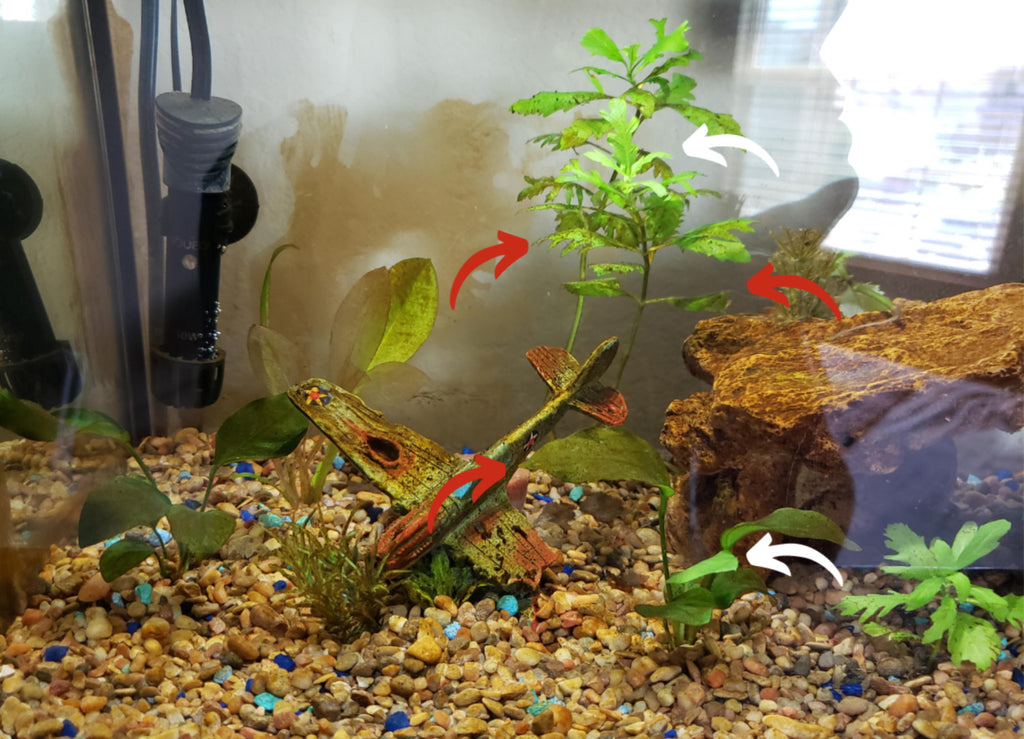
In this poorly set up low tech tank, plants that do not receive enough nutrients and carbon to sustain their existing mass will continually channel energy to maintain new growth (white arrows), while old growth will always look bad as the plant does not have enough energy to defend them against algae (red arrows). Where the base parameters of the tank are insufficient to support good plant health, this symptom of algae on older leaves will never disappear. The lack of Carbon in many low tech tanks is why the lower stems of stem plants are always bare.
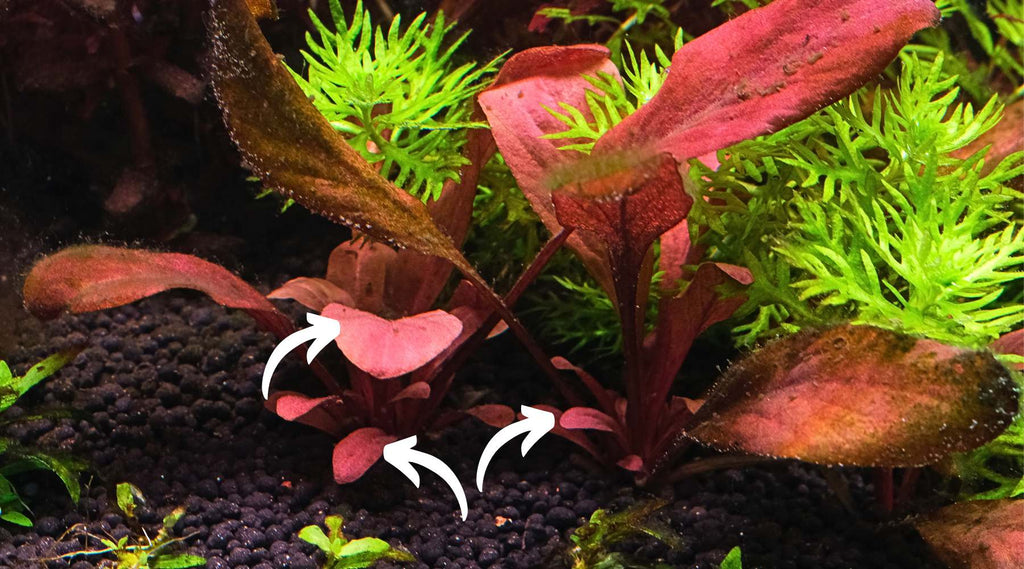
This Samolus parviflorus red was recently transplanted into this tank. The plant produces new leaves that are adapted to the current tank conditions – these new leaves are healthy and remain algae free (white arrows above). The older leaves contain machinery that is optimized for the previous tank, and the plant abandons them; the deteriorating old leaves attract algae.
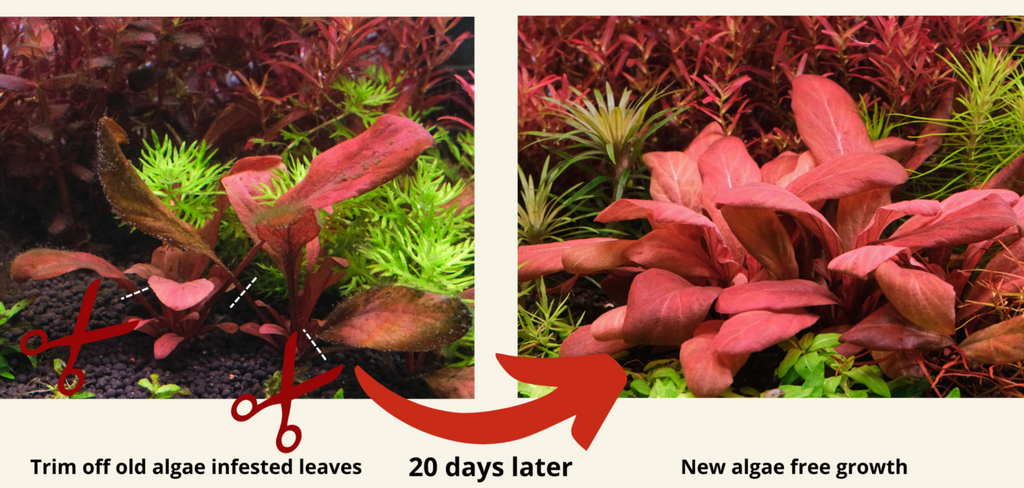
Just 20 days later, the plant grows a new bunch of leaves adapted to the new tank conditions. As long as conditions in the new tank are kept stable, this healthy plant will have no issue maintaining the health and quality of its older leaves.
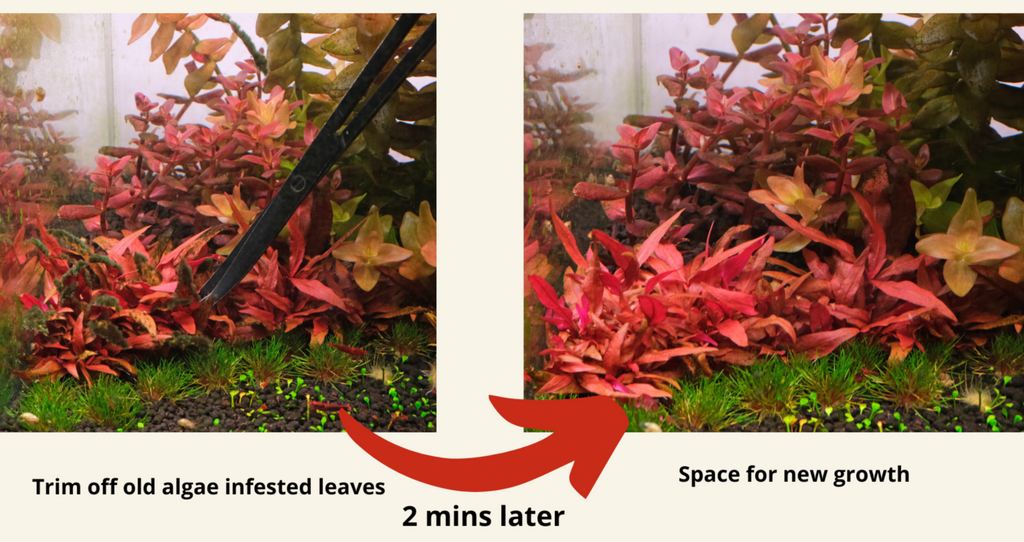

In this example, nutrient levels in the tank were increased significantly within a short period of time. (residual NO3 levels in the tank rose from 1ppm to 8ppm within a couple days) The increased in nitrogen levels caused the plant to reprogram to increase growth rates to make use of the newly available nitrogen. Waste proteins and metabolites are ejected from the plant as this happens and algae spawns on the leaf surfaces. Even though growth conditions have become more favorable, the short term reprogramming of the plant’s internal machinery causes algae to bloom. This will fade as the plant regains its health, however, sometimes persistent forms of algae can appear. In such cases, a dose of algicide is a quick cure.
The key lesson from above is that stability is very important. Most common plants are adaptable within a wide range of nutrient and even CO2 levels. Rapidly switching between high and low levels of nutrients or CO2 and triggering adaptation shock in plants is what triggers algae.
How much plant mass?
Now that we know that healthy plants deter algae, how much of the tank do we have to plant for the tank to gain good defenses against algae? When the substrate is 80-100% planted, healthy plant mass keeps algae at bay. The main focus of the aquarist in such tanks is to maintain plant health by ensuring adequate nutrients/CO2/light are available and by preventing over-crowding by regular trimming and replanting. Head here to see an example where we cure an algae filled tank without algicides (just by using plant growth).
Due to the algae resistant nature of fully planted layouts, it allows the usage of higher lighting and nutrient levels to grow difficult plant species that have higher light and nutrient requirements.
As plant mass increases, demands for CO2 and nutrients increase – the main job of the aquarist is to make sure plant demand is fulfilled. Competition for nutrients can elevated in fully planted setups that are growing fast, and under-dosing fertilizer in such tanks results in the weak plants, deteriorating older growth and algae.
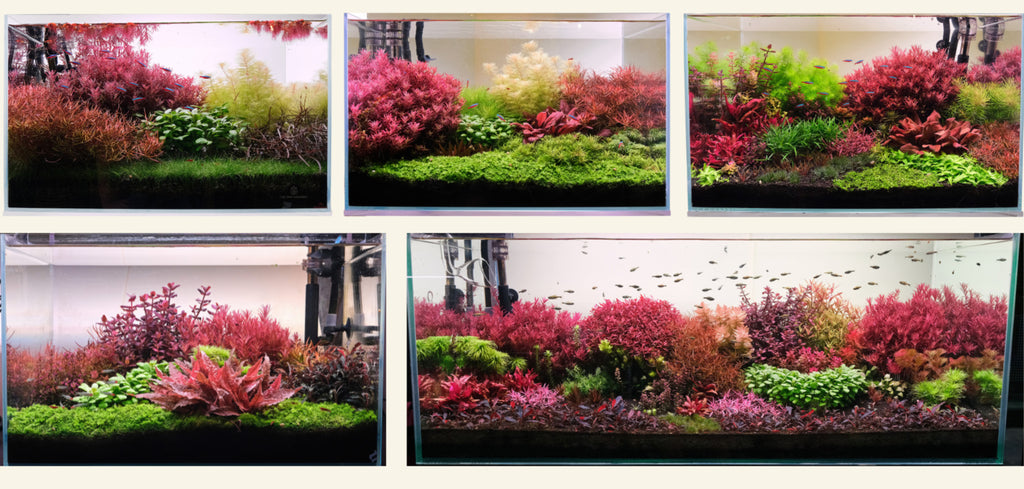
At 2hr Aquarist, our plant focused tanks are naturally algae resistant due to the high plant mass. However, plants also compete with each other for space. Plant husbandry is critical to maintaining a densely planted tank that does not suffer from over-crowding. All tanks above are CO2 injected and dosed with APT Complete fertilizer.
Summary
- Healthy plants are algae resistant, unhealthy plants attract algae.
- Having regular fertilization, and a strategy to get adequate carbon into the tank is essential for good plant health.
- Plants can be growing, yet be under stress or be unhealthy.
- Old, deteriorating leaves attract algae and should be cut off.
- Stability matters. Plants are adaptable, but adaptation stress causes algae.
- Over-crowding leads to poor plant health and quicker decaying old growth. Prune consistently; a tank fully filled with new growth is extremely algae resistant.
- Tanks that are 80-100% planted are much more algae resistant compared to lightly planted tanks.
2.Light and nutrient control
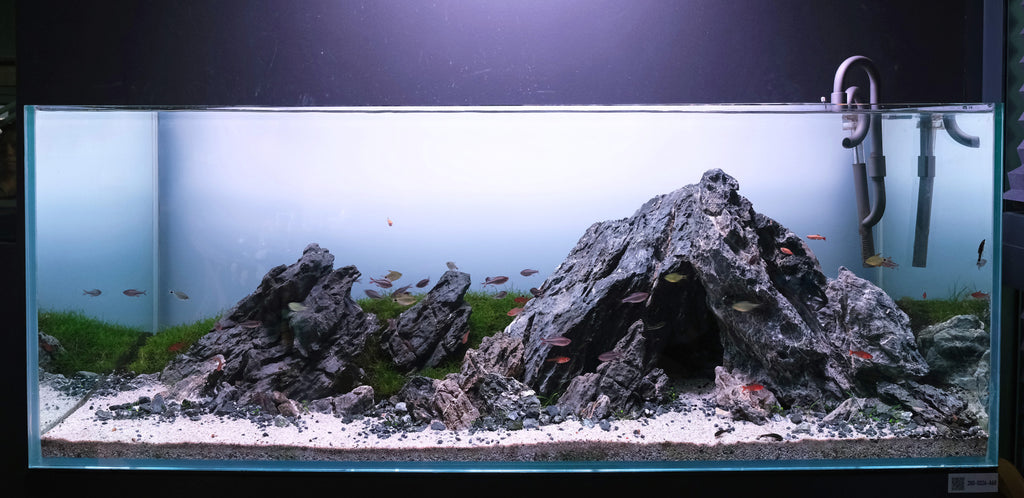
We discussed fully planted tanks using plant mass to deter algae in the above section, how about very sparsely planted tanks? The Iwagumi above is less than half planted, and only planted with delicate ground cover plants no less. The strategy for keeping algae at bay in such setups is thus quite different from the fully planted ‘Dutch style’ examples seen previously.
Lighting and nutrients, together with CO2 are the 3 major influencers of plant growth in aquatic habitats. The stronger the lighting, and the more nutrient availability there is for plants to uptake, the faster the potential growth rates. However, strong lighting coupled with organic waste or stressed plants trigger algae spores to bloom. Once these spores have bloomed, the fully formed algae grows faster when light and nutrient levels are plentiful. In high plant mass tanks that are naturally algae resistant, using higher levels of light and nutrients in the water column does not trigger algae as the plant mass outcompetes algae and denies algae a place to spawn. In low plant mass tanks, plant dominance is not there to help, and thus we need to minimize algae triggers instead by limiting light levels and by limiting certain nutrients in the water column.
How low is “low light”?
Head here to read about what is PAR. Below 60umols of PAR, the incidence of triggering algae is greatly reduced compared to tanks that run more than 100umols of PAR. For hardscape heavy tanks, running them at between 40-60umols of PAR at the substrate level allows the hardscape to remain relatively algae free. This level of PAR is sufficient to grow most species of green plants, including the carpeting plants used for Iwagumi setups. Contrary to popular belief, carpeting plants do not require high light to spread if CO2 levels are sufficient.
CO2 injection is effective even in low light tanks. CO2 injection with low light levels is one of the most stable combinations available in the hobby.
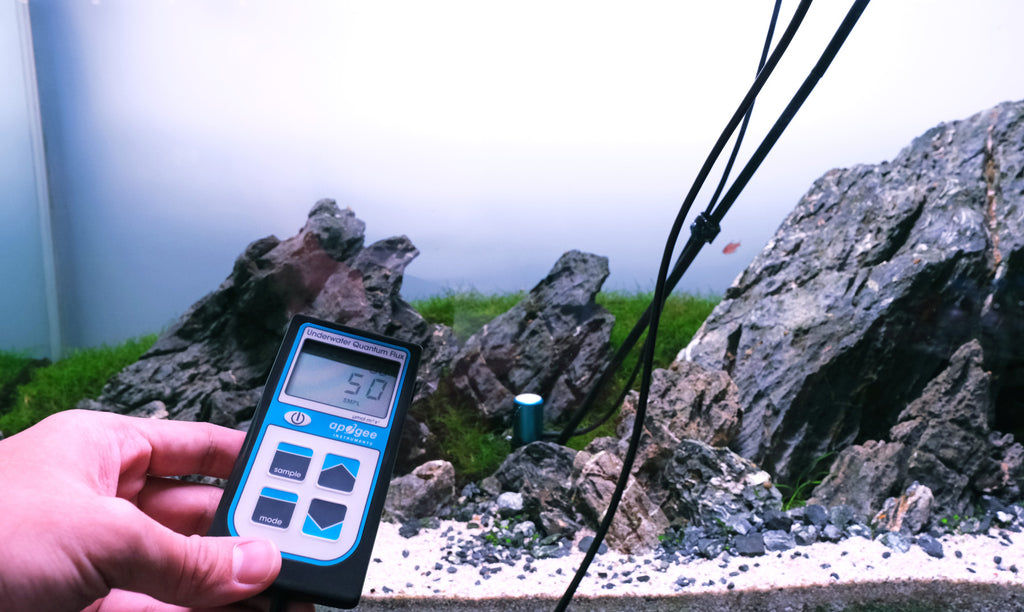
The Iwagumi above uses just 50umols of PAR a the substrate to grow a dwarf hair grass carpet. Carpeting plants are not high light plants contrary to popular belief. Species such as Dwarf hair grass and Monte carlo will spread in 40-60umols of PAR as long as CO2 levels are decent (20ppm +). Running a tank at 50umols of PAR vs 100umols of PAR is a world of difference when one does not have the defense against algae that a densely planted tank gives.
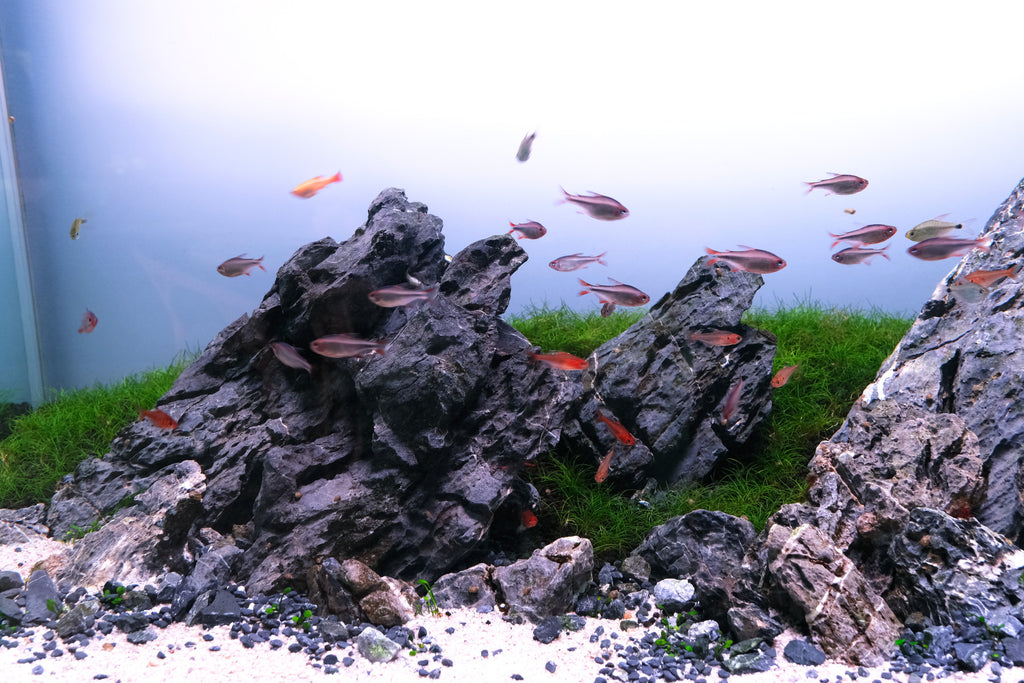
Light intensity guide
This is a guide to the appropriate light intensity as measured on the surface of the substrate (more details of how to measure this in the light section). Using the minimum amount of light required to grow the style of tank that you want is a smart way to reduce algae.
- 15-30umols of PAR: Low light plants such as ferns, mosses, Cryptocoryne, Anubias, Bucephalandra species grow well. If you are growing purely shade plants, it is smart to stay in this range.
- 40-60umols of PAR: Can grow any common commercially available green aquatic plant (when coupled with optimal CO2 levels). However, this gives little allowance for shading issues in crowded tanks. Most nature style and Iwagumi style tanks that do not require high density do well at this range.
- 100-150umols of PAR: Colored stems will display better coloration and carpets spread very fast as light levels increase, at the risk of more algae issues. Tank cleanliness and plant health must be maintained at optimal conditions to prevent run-away algae. Allows for increased planting density for light demanding plants. Most experienced aquarists can do well in this range with regular upkeep. Tanks should be more densely planted to avoid algae.
- 200umols of PAR & above: Marginal gains to plant growth form and coloration starts to be outweighed by large potential instability of algae outbreaks. Might be useful inducing stronger coloration in shorter stems close to substrate; and for farming purposes. Should only be used by aquarists used to maintaining already algae-free tanks.

Light duration
- Minimum of 5-6 hours for new tanks that want to minimize triggering algae.
- 7-10 hours is common for average, stable tanks.
- 12+ hours; marginal gains to plant growth rates, increased chances of algae incidence. Suggest using moonlighting/lower powered display lighting if extended lighting hours is desired for viewing purposes.
Having an adjustable light system gives flexibility. Changing the number of hours as well as intensity, by using dimmers or hanging kits, can change outcomes considerably.
Power timers plug into standard power outlets and allow easy programming of when lights turn on/off.
Moving Nitrogen & Phosphorus into the substrate
Besides limiting light levels, the other action we can do to reduce triggering algae is moving Nitrogen and Phosphorus into the substrate. What does this mean? This means feeding the rooted plants Nitrogen (N) and Phosphorus (P) through the substrate usage of a rich aquasoil, rather than providing these nutrients through water column dosing. This allows us to dose a water column fertilizer that has reduced or no N&P.

In Iwagumi setups, using a rich aquasoil instead of sand allows one to root feed the plants nutrients instead of relying on heavy water column dosing.
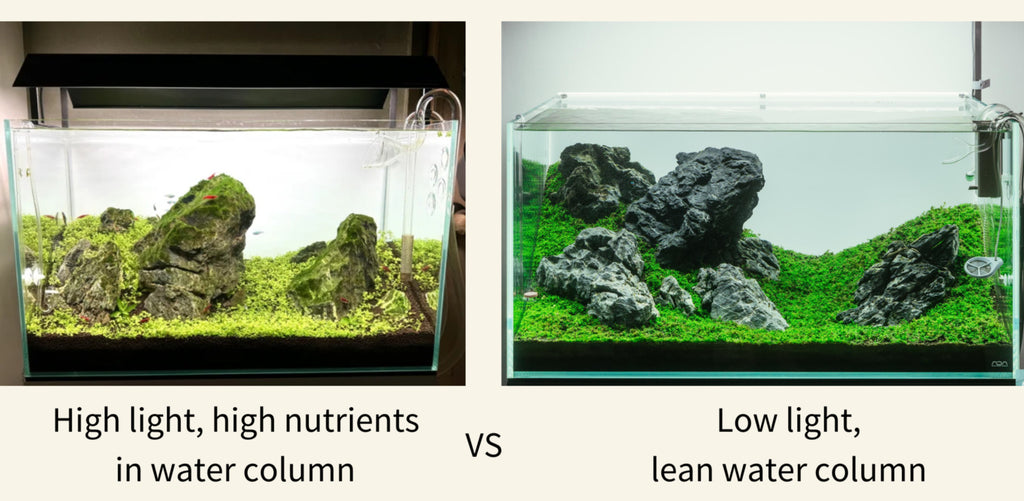
One can most certainly grow in an Iwagumi using more light and nutrients in the water column. While the carpet will spread faster in a high light, high nutrient tank, the tendency is that green algae will also grow on the hardscape readily.
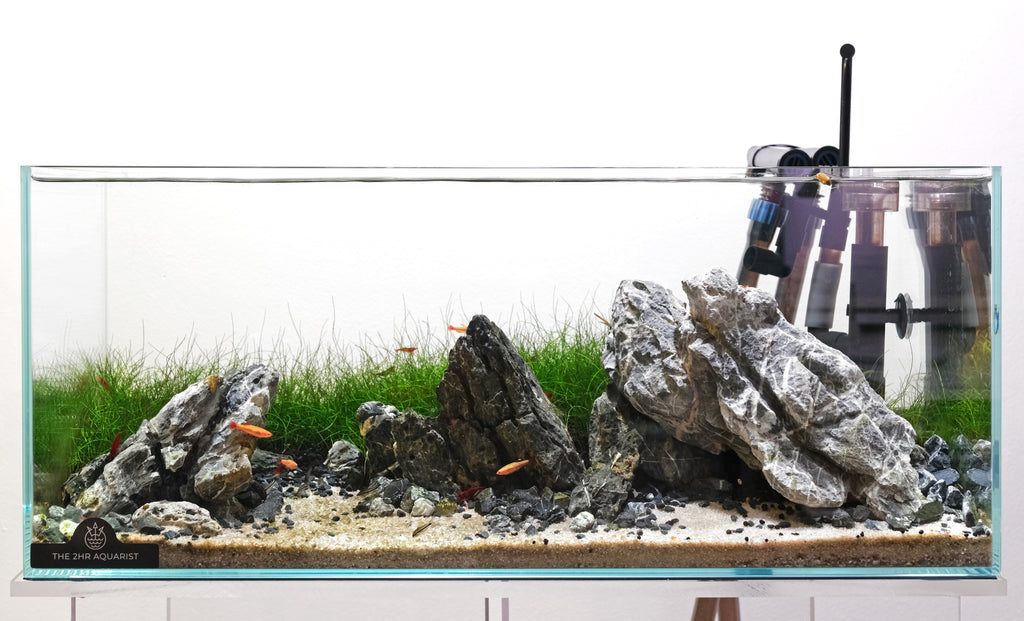
In this Iwagumi layout, we use around 40 umols of PAR on the substrate level. Additionally, we root feed the plants nitrogen and phosphate purely from the substrate, by using a water column fertilizer that is free from nitrogen and phosphate (APT 1).
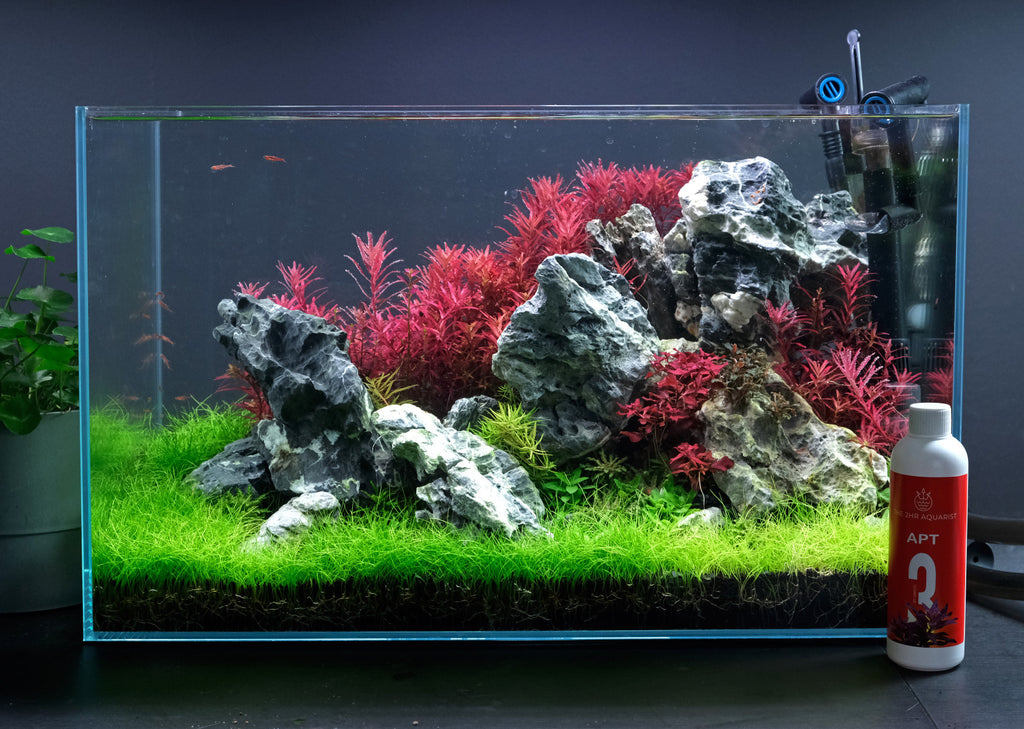
For tanks where there is some hardscape usage, but also a mix of colored plants, a balance has to found. In this tank we use 120umols of PAR on the substrate. This light level is high enough to give good coloration on red plants and good density on background stems, however, keeping the rocks bright white is difficult. We also use a rich aquasoil substrate to move N into the substrate so that we can dose less N in the water column. We dose an N limiting fertilizer into the water column (APT Complete); Nitrate levels for this tank bottom out to 0ppm 24 hours after dosing.
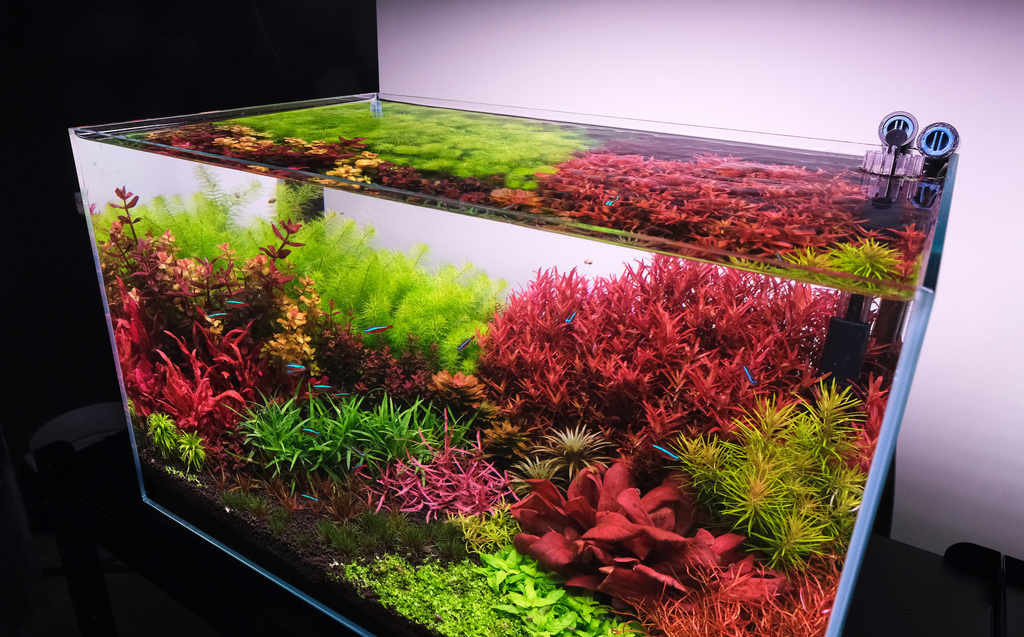
In this setup, we run 200umols of PAR at the substrate level in order to get deeper reds and denser growth. The high plant mass in the tank defends the environment from algae – notice how most of the substrate is covered up by plants. In such tanks we worry more about nutrients running dry – dosing a water column fertilizer regularly and the usage of a rich aquasoil substrate prevents nutrient levels from bottoming out.
Summary
- Using the least amount of light necessary minimizes algae triggers.
- If you are not growing colored plants, staying between 40-60umols of PAR makes the tank much easier to manage.
- If you are running very high PAR (>150umols at substrate), you need very high plant mass for an algae resistant tank.
- Root feeding plants N/P by using a rich aquasoil allows one to have less N/P in the water column. Having less N/P in the water column reduces algae incidence in sparsely planted tanks.
- Using a rich aquasoil prevents nutrients from bottoming out in a densely planted tank.
3.Organic waste & Biological Maturity of the tank
These two concepts flow together. Following the same train of thought that deteriorating plant matter triggers algae blooms, organic waste (whether by livestock or plants) is one of the key triggers for algae blooms. Having efficient bio-filtration and a matured tank environment leads to quicker breakdown of organic waste and ammonia, minimizing trigger time for algae. This means that having an environment that promotes microbial activity, that allows bacteria to break down waste products more quickly & efficiently has a large impact on the tank environment.
Many microbes also consume algae directly as food – diatoms, which are common in new setups, disappear once the tank has matured without any other intervention. Newbies panic when they see diatoms appear in a new setup, while experienced aquarists just snooze and wait for it disappear.
In this video, and in many other videos on the channel, you can observe microbes consuming algae.
Sustaining the delicate microbial ecosystem
Microbes are delicate and heavy usage of harsh chemicals (like algicides) will affect them. This is why many aquarists get caught up in the never ending loop of killing algae – having new algae – looking for new cures, whist never having the tank in a sustained period of being algae free. Prevention is better than cure – if you dose algicides, spot dose them in problem areas early, rather than nuke the whole tank.
Most microbes benefits from flow and good oxygen levels, so having good flow through the tank is beneficial. Good oxygen levels can come from either having a lot of plants photosynthesizing or good gaseous exchange; this means having a clean water surface and exchange of oxygen rich surface water with layers deeper in the tank. Microbes live on surfaces, including those of plants. Having substrates where surface area is ample and bio-active such as aquasoil, gives a much better habitat for microbial population compared to pea gravel. Having a good amount of filter media also allows housing for microbial communities.
For a new tank, adding mulm and/or squeezing detritus from a matured filter is the fastest way to seed a new tank with microbial life.
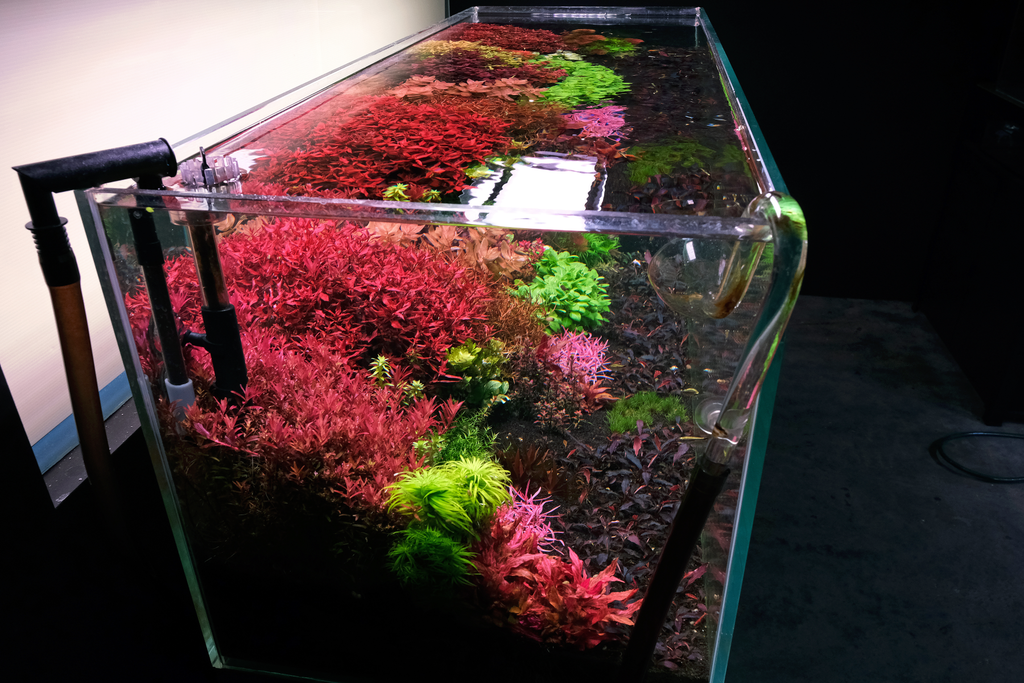
Dealing with organic waste
While dissolved organic waste is easily removed through water changes, excessive mulm on the substrate can also trigger algae. The idea of a soil substrate getting dirty is an extremely weird concept for newer hobbyists – after all, isn’t soil just an accumulation of dirt? The organic waste accumulated on the surface of aquasoil is very different from the components that make up aquasoil. This is better understood through the idea of composting – many gardeners compost their kitchen waste before adding it to their gardens. This creates a biologically stable media compared to the overly labile conditions that would result by adding raw kitchen scraps to the garden soil directly. Similarly, aquasoil is made up of weathered organics and clay, which is much more biologically stable compared to the undigested organic waste material that accumulates on the substrate surface over time.
While the accumulation of organic waste on the aquasoil substrate does provide some nutrients, it does so at the expense of being a significant trigger for algae. It is much cleaner to remove the labile organic waste layer and fertilize the tank through pure elemental salts – this results in less algae triggers.
Water changes should not just focus on replacing tank water – aquarists should also use this chance to siphon away detritus that has build up at the substrate layer. More detailed steps on how to maintain aquasoil substrates long term here.
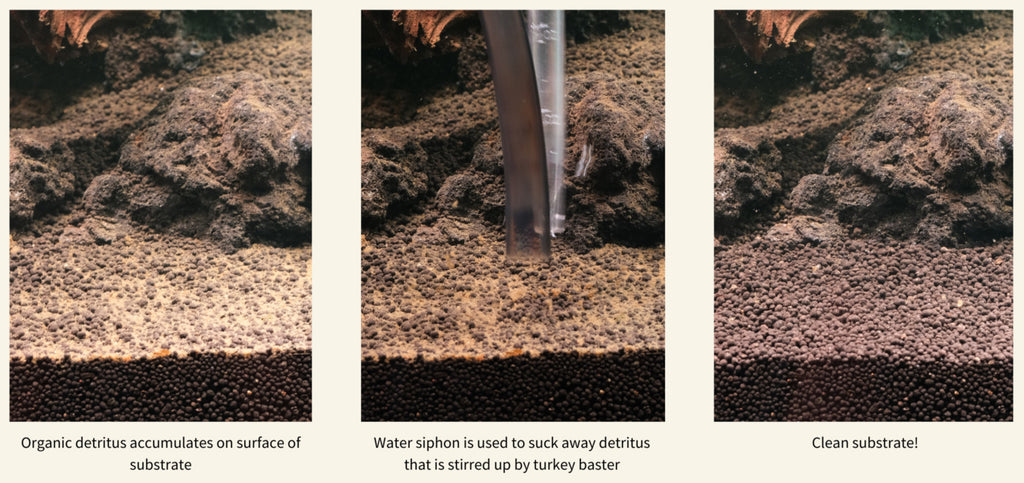
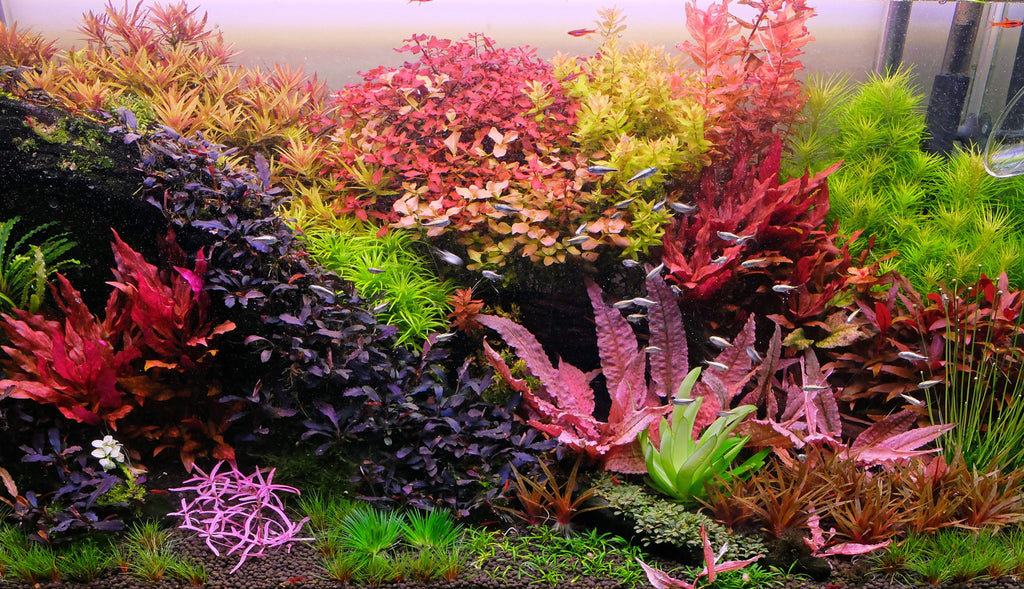
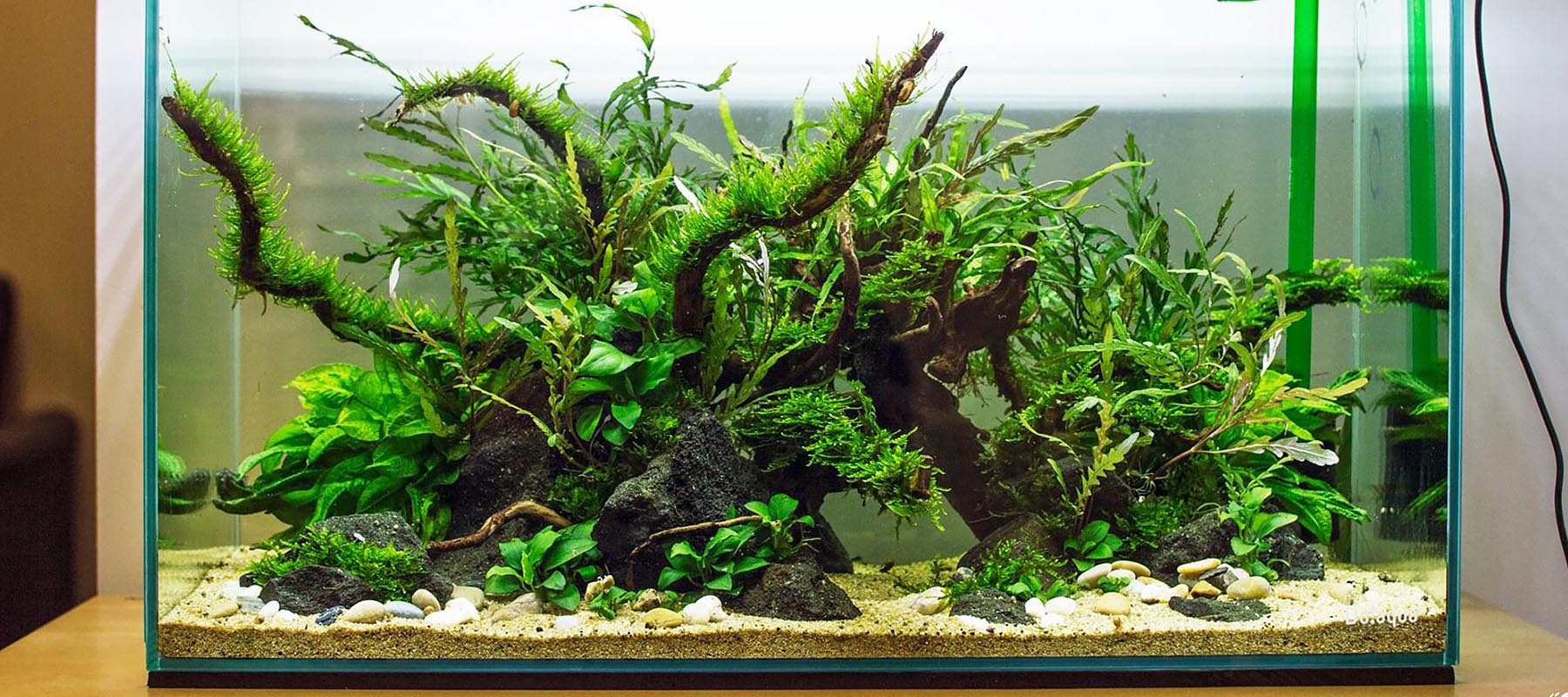

Shrimps, snails and other micro-fauna keep the tank clean by breaking down organic debris. This sand path with mixed carpets is more than a year old; fortnightly light vacuuming of the surface keeps it clean.
Summary
- Regular water changes (30-80% weekly), coupled with siphoning of substrate detritus makes a huge impact on organic waste levels.
- Removal of old/decaying growth. This requires topping and replanting – cutting off and replanting the top portion of stem plants, while discarding the deteriorating bottoms. Details here.
- Servicing clogged filters. Depending on your bio-load this could be done as frequently as every fortnight or up to every 3 months. Using a filter with an easy to remove pre-filter chamber that does not require dismantling of the whole filter is an easy way to make maintenance easy.
- Maintain high oxygen levels in the tank through sufficient gaseous exchange mechanisms. Higher oxygen levels is important for bacteria activity.
- Using organic/soil-based substrates or appropriately sized sand (2-3mm) in the tank rather than inert large sized gravel. Increased porosity allows better bacteria colonization.
- Filter flow rate of 5X to 10X of tank size. 1000L/hr filter on a 200L tank for example.
- Maintaining stable water parameters long term. This also means avoiding spikes of toxic elements (heavy metal content in water for example).
- For a new tank, adding mulm and/or squeezing detritus from a matured filter is the fastest way to seed a new tank with microbial life.
Putting it all together, FAQs
Hardscape heavy or plant heavy?
Tanks that are more than 80% planted can depend on plant dominance to immunize their tank against algae. These tanks can use more light and fertilizer than lighted planted tanks. Picky species that require higher light/fertilizer to grow are almost always grown in such plant focused tanks. Plant heavy tanks require much more maintenance – trimming and replanting are among the most time consuming tasks when maintaining a planted tank long term.
Tanks that have a ton of hardscape need to run lower light levels and leaner water column fertilization to be naturally algae free. However, one can also do intensive maintenance on such tanks to keep them free from algae – many competition aquascapers change water daily, which allows them to run higher light on hardscape heavy tanks while avoiding algae.

Competition aquascaper Matthew manes grows out his competition tank above using APT Complete; the same fertilizer we use in our plant focused tanks. However, he does very regular water changes to keep algae at bay in his hardscape focused layout.
Are you choosing to run high light just for 1 or 2 species in a tank?
Sometimes we raise the light levels in the tank just to accommodate 1 or 2 picky species that require more light to grow well. One should question whether the trade off is really worth it. Sometimes just adding 1 or 2 troublesome species increase tank maintenance tremendously.

In this tank, all plants except the Rotala blood red SG bush at the back would be fine growing at low light levels (<60umols of PAR). We bumped up light levels to 120umols just to maintain the red stem plant bush in good color.The red stems are quite key to the design of the overall layout in this case. We do more frequent water changes to maintain the sand front in the higher light levels.
Looking for a low maintenance tank?
A low light tank that is fully planted with easy, slower growing plants is the easiest tank to maintain algae free. Slower growing plants also means lower maintenance with regards to trimming and other horticulture work. Avoid stem plants and non-green plants.
Another approach is to let hardscape carry the weight of the design of the tank, so that one does not need to take care of so many plants.

Will CO2 injection solve all my problems?
Many folks running low tech tanks are overly ambitious with their plant selection. Depending on how the low tech tank is set up, a lack of access to carbon is often the biggest issue for many plant species, and unhealthy plants are an algae magnet. Being overly ambitious with plant selection is the biggest reason many plants do not do well in low tech tanks. Choosing species that are well suited for low tech tanks greatly improve success rates when CO2 injection is not available. Head to this page for a selection of plants that are proven to do well in non CO2 injected tanks.
CO2 injection, when available, boost growth rates for most aquatic plant species by 7x to 10x. Plants use more Carbon as part of their growth than all other nutrients combined. CO2 injection allows tanks to out-grow their algae problems. When plants grow faster, it also allows the aquarist to learn faster, so CO2 is not only an accelerator for plant growth, it also accelerates the learning cycle for aquarists. However, CO2 does not act alone. It needs to be paired with a good fertilizer dosing regime, and ultimately good maintenance to be effective in a tank.
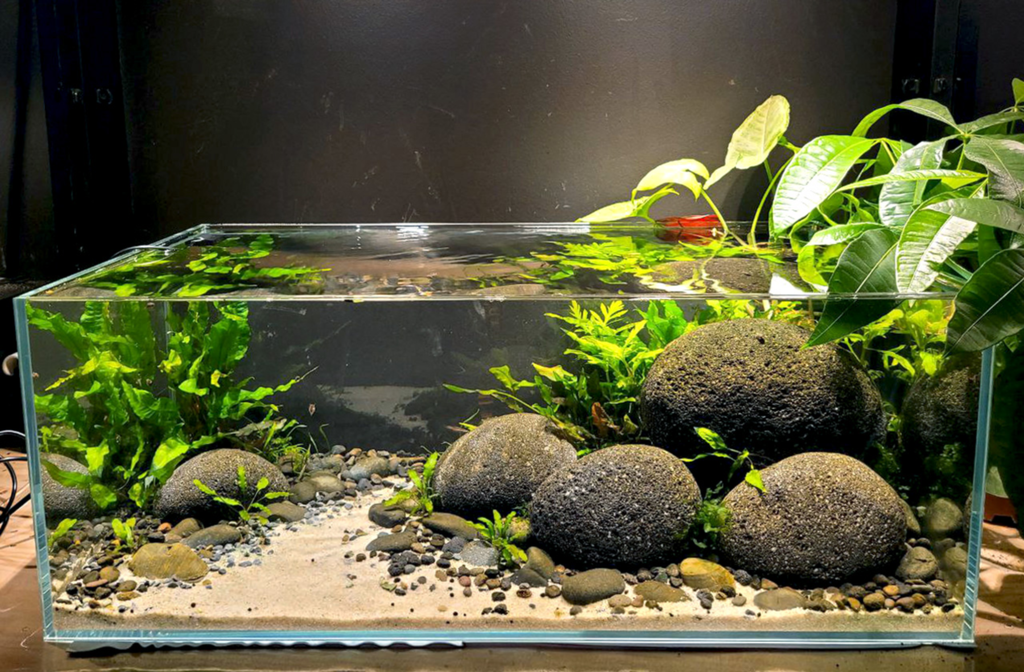
Here are links for further reading on the following topics:
1. How to clear algae without algicides
2. How to use algicides to clear algae
3. Detailed steps to tank cycling
4. What nutrients do aquarium plants needs for growth?
5. Section on CO2 for planted tank
6. Section on aquarium plants care guides
7. For detailed steps to control specific algae, click here.
8. More detailed steps on how to maintain aquasoil substrates here.


